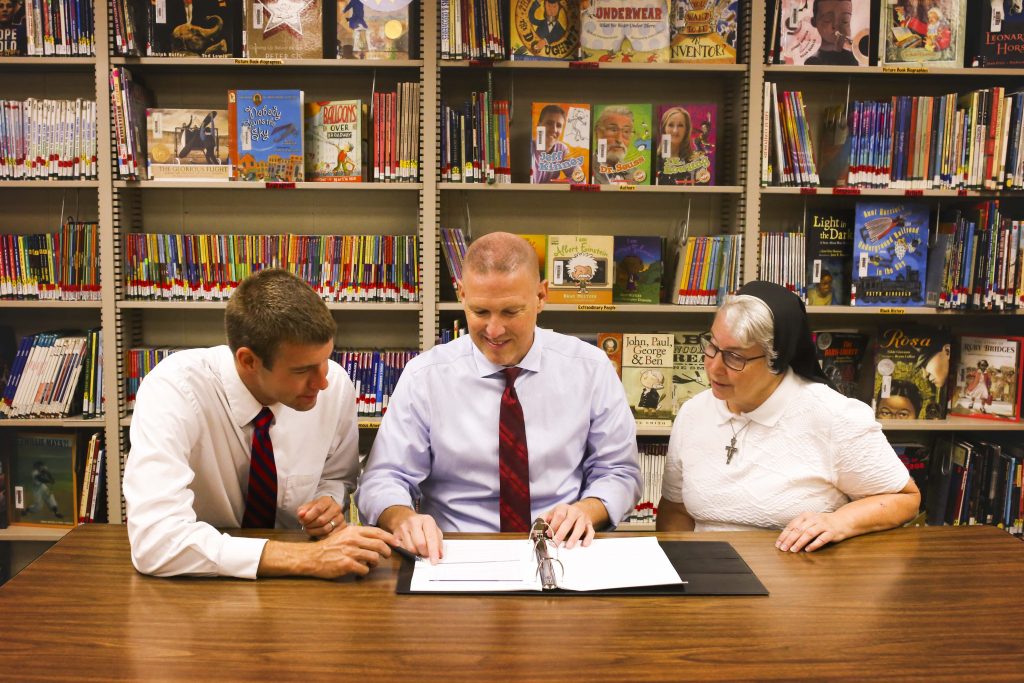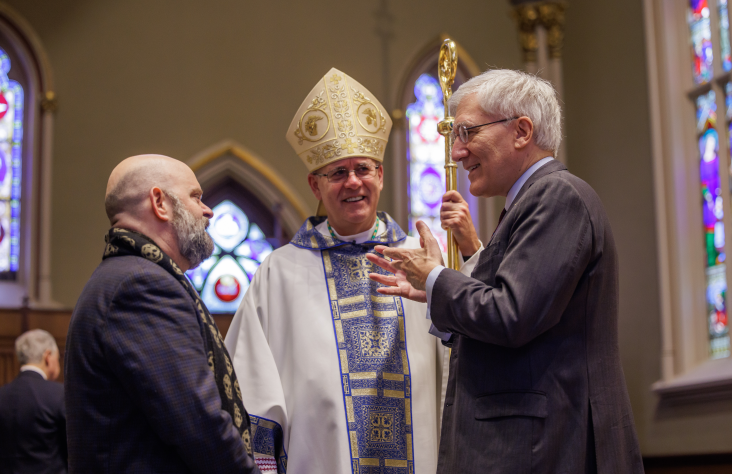August 6, 2018 // Schools
Diocesan schools committed to continuous improvement
In April 2016, schools of the Diocese of Fort Wayne-South Bend underwent a systemwide accreditation process through the national accrediting body AdvancED. AdvancED’s mission is to ensure that all learners realize their full potential and that schools provide an environment that continually strives for improvement.
After consulting with the four other Catholic dioceses in the state of Indiana, the decision to approach accreditation as a diocese versus individual schools was made.
“The AdvancED team came over three days to evaluate our diocesan schools. They met with the steering team and diocesan administrators, visited many of our 43 schools, reviewed many school and system documents and interviewed numerous stakeholders,” said Amy Johns, associate superintendent of schools. “From that process, recommendations were made to the diocese to better ourselves.”
During the original 2016 visit, some priorities noted were labeled immediate and needed to be addressed within the first two years. AdvancED also suggested other changes but deemed them long term, meaning integration could occur within the next five years.
“Part of the systemwide accreditation process is conducting our own Continuous Improvement Journeys, or internal reviews, of each school,” said Johns. This means that before the 2021 systemwide visit occurs again, all 43 schools in the diocese will have participated in a one-day, on-site visit by a team of colleagues that includes administrators, diocesan staff and teachers recommend by building principals.

Administrators at St. Charles Borromeo School, Fort Wayne, look over the school’s exit slip. St. Charles was one of the first schools in the diocese to be evaluated last year by an internal diocesan team as part of a rigorous Continuous Improvement Journeys accreditation process. From left are assistant principal Kevin Hoersten, principal Robert Sordelet and assistant principal Sister Genevieve Raupp, OSF. — Emily Diehm
Continuous Improvement Journey team members are prepped before each visit with a course designed to familiarize them with the Continuous Journey process and the documents that will be used during the internal review.
“A team chair works closely with the school principal to arrange the day, from the schedule to interviews to documentation,” said Johns. “The team has access to review everything before the actual visit in order to get a good sense of the school and what they would like to see improved.”
During the full-day visit, the team will spend time observing in classrooms. Team members will also interview school staff, parents, students and other stakeholders regarding school climate, strengths and goals. School improvement tactics and timelines for changes will then be discussed.
At the completion of each visit, an exit report is compiled that notes areas in which a school excels, along with improvements that are needed. It will also assign a school rating using the AdvancED Standards Diagnostic Factors, which fall into three capacities: leadership, learning and resource. Team members are trained to note and observe factors that fall under each capacity.
Leadership capacity
• The institution commits to a purpose statement that defines beliefs about teaching and learning including the expectations for learners.
• Stakeholders collectively demonstrate actions to ensure the achievement of the institution’s purpose and desired outcomes for learners.
• The institution engages in a continuous improvement process that produces evidence, including measurable results of improving student learning and professional practice.
• The governing authority establishes and ensures adherence to policies that are designed to support institutional effectiveness.
• The governing authority adheres to a code of ethics and functions within defined roles and responsibilities.
• Leaders implement staff supervision and evaluation processes to improve professional practice and organizational effectiveness.
• Leaders implement operational process and procedures to ensure organizational effectiveness in support of teaching and learning.
• Leaders engage stakeholders to support the achievement of the institution’s purpose and direction.
• The institution provides experiences that cultivate and improve leadership effectiveness.
• Leaders collect and analyze a range of feedback data from multiple stakeholder groups to inform decision-making that results in improvement.
Learning capacity
• Learners have equitable opportunities to develop skills and achieve the content and learning priorities established by the institution.
• The learning culture promotes creativity, innovation and collaborative problem-solving.
• The learning culture develops learners’ attitudes, beliefs and skills needed for success.
• The institution has a formal structure to ensure learners develop positive relationships with and have adults/peers who support their educational experiences.
• Educators implement a curriculum that is based on high expectations and prepares learners for their next levels.
• The institution implements a process to ensure the curriculum is aligned to standards and best practices.
• Instruction is monitored and adjusted to meet individual learners’ needs and the institution’s learning expectations.
• The institution provides programs and services for learners’ educational futures and career planning.
• The institution implements, evaluates and monitors processes to identify and address the specialized social, emotional, developmental and academic needs of students.
Resource capacity
• The institution plans and delivers professional learning to improve the learning environment, learner achievement and the institution’s effectiveness.
• The institution’s professional learning structure and expectations promote collaboration and collegiality to improve learner performance and organizational effectiveness.
• The institution provides induction, mentoring coaching programs that ensure all staff members have the knowledge and skills to improve student performance and organizational effectiveness.
• The institution attracts and retains qualified personnel who support the institution’s purpose and direction.
• The institution integrates digital resources into teaching and learning operations to improve professional practice, student performance and organizational effectiveness.
• The institution provides access to information resources and materials to support the curriculum, programs and needs of students, staff and the institution.
• The institution demonstrates strategic resource management that includes long-range planning and use of resources in support of the institution’s purpose and direction.
• The institution allocates human, material and fiscal resources in alignment with the institution’s identified needs and priorities to improve student performance and organizational effectiveness.
In addition to the AdvancED factors, Continuous Journey team members also look for and evaluate the extent to which the school is following the National Standards and Benchmarks for Catholic schools, which hold it accountable for the excellence, rigor and faith nurturance that have been hallmarks of Catholic education. The standards and benchmarks that are evaluated include a school’s Catholic identity, commitment to faith formation, academic rigor, governance and leadership, and self-assessment practices.
Once the team has determined a school’s ratings for both AdvancED and National Catholic Standards, it will use the rating to determine Powerful Practices, Opportunities for Improvement and Improvement Priorities.
Powerful Practices reflect noteworthy observations and actions that have yielded clear results in student achievement or organizational effectiveness and are actions that exceed what is typically observed or expected in a school.
Opportunities for Improvement are those actions that will guide and direct schools to specific areas that are worthy of additional attention.
Improvement Priorities are developed to enhance the capacity of the school to reach a higher level of performance and reflect the areas identified by the Engagement Review Team to have the greatest impact on improving student performance and organizational effectiveness.
“The results determined using both AdvancED Standards Diagnostics Factors and National Standards and Benchmarks for Catholic schools are put together in an exit report and presented to the principal, school staff and pastor for each school,” said Johns. “The school then has the next five years to work on the areas where advancement is deemed necessary.”
The reports generated from each school visit stress the importance of and outline the process for continuous improvement that benefits every Catholic school student in the Fort Wayne-South Bend diocese.
Johns believes that including colleagues in the accreditation process goes beyond the obvious benefits of identifying areas needing improvement.
“The visits build community as evidence of implementing techniques and documentation are shared. This sharing of expertise is invaluable,” she said.
She is also excited that the schools will be evaluated by their own personnel, who understand the mission and purpose of Catholic schools.
“This unifying spirit has brought the schools together to truly improve one another,” said Johns.
The best news. Delivered to your inbox.
Subscribe to our mailing list today.






